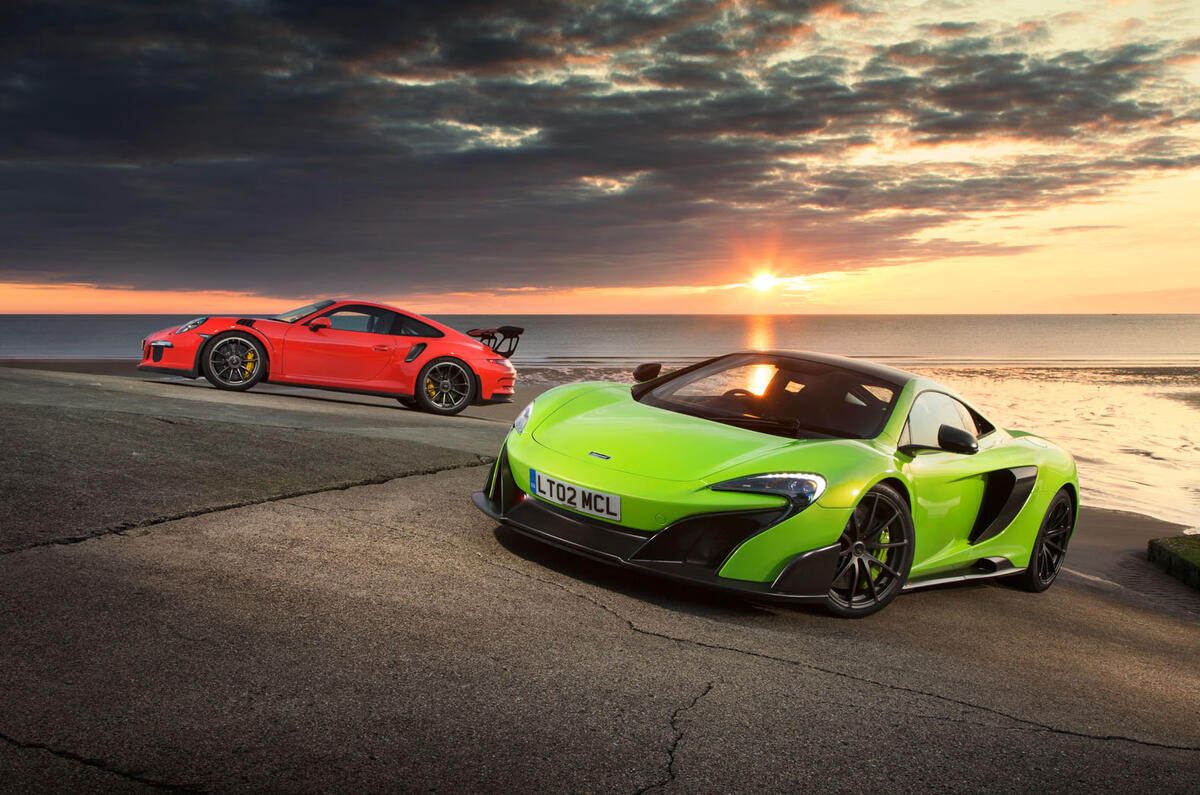Thursday, 9.23am: MIRA Proving Ground, nuneaton, west midlands - Thunderbolts are the least you’d expect. A scorched sky, some localised banshee wailing, perhaps – a pathetic fallacy worthy of an ancient Greek myth.
But the weather is anticlimactically calm and clear now as the very low, very loud and very angry-looking McLaren 675LT rolls to a stop in the car park at the MIRA Proving Ground.
Waiting in the same line of marked bays is the car I’ve driven here: one of only a handful of 2015’s other new model introductions with the potential to deny the McLaren the status that Woking would claim for it.
A nemesis? Maybe not – but a rival, a kindred immortal. Something equally special, too, if not more so. Because if this McLaren isn’t the most exciting driver’s car of the year, the new Porsche 911 GT3 RS may very well be.
Both of these cars were outstanding athletes before their latest performance makeovers. Both, as I’m banking you’ll already have read, have since been endowed with the kind of performance and handling superpowers that are normally reserved for cars with racing liveries. And right now, both are here at the start of a very special 400-mile, 36-hour UK road trip.
Read the full McLaren 675LT review
This won’t be the average comparison test. Extraordinary cars call for an equally extraordinary opportunity to reveal themselves – and that’s what these two are getting. And yet it’s already too late for a typical head-to-head verdict on the 675LT and GT3 RS. They’re sold out. So, much as we like to imagine there’s a throng of wealthy individuals waiting with bated breath for Autocar’s endorsement before ordering a new car, we can leave the final arguing and justifying aside.
Instead, we will simply find out what life on road and track is like in the company of not one but two of the most hardcore, most wanted sporting machines that this year, or any year, has to offer.
Thursday, 10.49am: MIRA’s mile straights
Our reason for starting at our favourite Midlands proving ground is simple: the Porsche will feature in a full Autocar road test in the weeks to come, and MIRA is where our road test performance benchmarking magic happens. So a morning of flat-out testing lies ahead, followed by an afternoon of photography.
Then it’ll be an early evening blast north-east, onto little-visited moorland roads once used by this magazine’s road testers to become acquainted with one of the McLaren’s legendary forebears.









































































































Join the debate
Add your comment
And the best engine?
Price £131,296; 0-62mph 3.3sec; Top speed 193mph; Economy 22.2mpg; CO2 emissions 296g/km; Kerb weight 1495kg; Engine 6 cyls horizontally opposed, 399cc, petrol; Power 493bhp at 8250rpm; Torque 339b ft at 6250rpm; Gearbox 7-spd dual-clutch automatic
That's amazing performance from a 399cc engine!
'go hard or go home'
fadyady wrote: This pretty
If the Porsche is a one trick pony as you describe it then isn't that kinda the whole point of it anyway?? It's not trying to be every car for every occasion is it, Porsche has plenty of alternatives in their line up if that is what is required and if it's only trick is to be one of the most rewarding car's to pilot available for the dedicated driver regardless of price point then hasn't it met it's brief?? The fact it's half the price of the LT surely makes it good value? Love the LT by the way, by far the most resolved car in their range if you discount P1
My bad
My bad. I should've said that this Porsche or this variant of the 911 is a one-trick pony compared to this McLaren which is an infinitely more complete car. And with 4-pots on the way, Porsches would soon be as innocuous, unexciting and safe as the Volkswagen Golf.
675LT
Now, if the 911 had a manual gearbox to go along with that engine I think the table would have turned. It would have cost another tenth to the GT RS which is slower anyway, but that wouldnt have mattered at all.